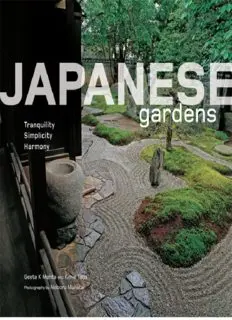Table Of ContentJGsk_0A_V2Prelim 0-7.indd 1 7/22/08 4:14:56 PM
JGsk_0A_V2Prelim 0-7.indd 2 4/21/09 4:27:38 PM
JAPANESE
gardens
Tranquility
Simplicity
Harmony
Geeta K. Mehta and Kimie Tada
Photography by Noboru Murata
Tuttle Publishing
Tokyo • Rutland, Vermont • Singapore
JGsk_0A_V2Prelim 0-7.indd 3 7/24/08 11:42:57 AM
Published by Tuttle Publishing, an imprint of Periplus Editions (HK)
Ltd., with editorial offi ces at 364 Innovation Drive, North Clarendon,
Vermont 05759 USA and 61 Tai Seng Avenue #02-12, Singapore 534167.
Text copyright © 2008 Periplus Editions (HK) Ltd.
Photos copyright © Noboru Murata
Project Coordinator: Kaoru Murata
All rights reserved. No part of this publication may be reproduced
or utilized in any form or by any means, electronic or mechanical,
including photocopying, recording, or by any information storage and
retrieval system, without prior written permission from the publisher.
Library of Congress Cataloging-in-Publication Data
Mehta, Geeta K.
Japanese gardens : tranquility, simplicity, harmony / Geeta K. Mehta
and Kimie Tada ; photography by Noboru Murata. -- 1st ed.
p. cm.
1. Gardens, Japanese. I. Tada, Kimie. II. Title.
SB458.M44 2008
712.0952--dc22
2008027111
Distributed by:
North America, Latin America and Europe
Tuttle Publishing
364 Innovation Drive
North Clarendon, VT 05759-9436 U.S.A.
Tel: 1 (802) 773-8930; Fax: (802) 773-6993
[email protected]
www.tuttlepublishing.com
Japan
Tuttle Publishing
Yaekari Building, 3rd Floor
5-4-12 Osaki; Shinagawa-ku; Tokyo 141 0032
Tel: (81) 3 5437-0171; Fax: (81) 3 5437-0755
[email protected]
Asia Pacifi c
Berkeley Books Pte Ltd
61 Tai Seng Avenue
#02-12, Singapore 534167
Tel: (65) 6280-1330; Fax: (65) 6280 6290
[email protected]
www.periplus.com
Printed in Singapore
11 10 09
5 4 3 2
TUTTLE PUBLISHING® is a registered trademark of
Tuttle Publishing, a division of Periplus Editions (HK) Ltd.
PREVIOUS PAGE An engawa porch at the Ishikawa International Salon
unites the interior of the house with the garden.
RIGHT This view at Shisen-do includes raked sand in the foreground,
clipped azaleas in the mid-ground, and large trees in the background.
NEXT PAGE Elements often found near the pond in a Japanese garden
include a yukimi-doro lantern, iris flowers, and a half moon bridge.
JGsk_0A_V2Prelim 0-7.indd 4 4/21/09 4:27:41 PM
JGsk_0A_V2Prelim 0-7.indd 5 4/21/09 4:27:46 PM
JGsk_0A_V2Prelim 0-7.indd 6 7/24/08 11:43:00 AM
contents
8 Gentle Acts of Nature, Time and Man
20 TEMPLE GARDENS
22 Ikegami Honmon-ji, Tokyo
30 Honen-in, Kyoto
36 Koto-in, Kyoto
44 Shisen-do, Kyoto
54 Ryoan-ji, Kyoto
64 Shinju-an, Kyoto
72 PRIVATE GARDENS
74 Mimou House, Nonoichi
82 Wafudou of Ueda Soko Ryu, Hiroshima
-
92 Yabashi House, Ogaki
98 Segawa House, Tokyo
106 Shigemori House, Kyoto
114 Kamoizumi House, Higashihiroshima
122 Suya House, Nakatsugawa
130 Araki House, Kyoto
136 PUBLIC GARDENS
138 Kamo Hanashobu Garden, Kakegawa
144 Ean Tea House, Tokyo
152 Ishikawa International Salon, Kanazawa
160 Nomura House, Kanazawa
168 Happo-en, Tokyo
176 Seison-kaku, Kanazawa
184 Kincharyo, Kanazawa
192 Shunka-en, Tokyo
200 International House of Japan, Tokyo
206 Glossary of Garden Terms
208 Acknowledgments
JGsk_0A_V2Prelim 0-7.indd 7 7/24/08 11:43:02 AM
Gentle Acts of Nature,
Time and Man
Between dreamtime and time, At their best, gardens are reminders of our own divinity. A
Beyond time and thought, the fresh of the morning, beautiful garden resonates into the depths of our soul, fresh as the
early morning any time we care to be fully present in it. Once it is
A morning of the afternoon, a morning of the evening,
internalized, you can return to such a garden many times, and be
A morning of life, a sparkling dewdrop,
surrounded with a fresh, nurturing energy. How does one create
A garden of the soul, a garden in the soul, and care for such a garden? This is the central question that the best
A garden Japanese gardeners have been persistent in asking and answering.
The authors of this book embarked on a beautiful journey to
understand the Japanese garden. We looked at enchanting gardens
Gentle acts of nature, time and me
where the efforts of man, nature and time complement each other,
Woven in beauty, a soul nurtured and we saw many more gardens of exquisite beauty than fi t into
A hoe, a shear, a seed, held for now this book. Many of these have evolved well beyond their original
concept, so that the designers would scarcely recognize them now.
In my transparent hands, then simply let go
A good example is the “moss garden” of Saiho-ji in Kyoto, where
From me the past, to me the future
moss was not even a part of the original design, but has grown over
A garden hundreds of years, and now defi nes the garden.
While human ingenuity and geometric perfection inform
—Geeta K. Mehta most other garden traditions, Japanese gardens are different. Most
gardens around the world are hierarchical, arranged around a
building—which is often the main reason for the garden’s existence.
In Japan, it is the other way around. In the best Japanese gardens,
tea huts and other buildings are tucked to one side of the garden
A characteristic feature of Japanese gardens is their close relationship so as to be as unobtrusive as possible. It is said that aristocrats of
to architecture. Each element is designed keeping the others in mind. the Heian period located their gardens on a site fi rst, and then
Simply sliding away walls made of shoji doors can combine the interior and constructed villas in the space left over.
exterior spaces. Views of the garden are a major consideration in situating Japanese gardens are very different from Chinese gardens, to
the buildings on the site. which they nevertheless owe a large debt. Things Chinese were
8
JGsk_0B_V2Intro 8-19.indd 8 7/22/08 4:24:51 PM
JGsk_0B_V2Intro 8-19.indd 9 7/22/08 4:24:58 PM

